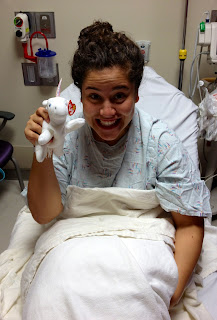My Incision Decision
Disclaimer: If you're squeamish, I recommend proceeding with caution. But I still think you should read this post, because open heart surgery is actually really fascinating when you learn more about it.
Nutshell: The surgeon makes an incision in the center of the chest, breaks the sternum with a surgical saw, and then places a retractor between the two halves of the sternum to open up the space and visualize the heart. After the repair is complete, the sternum is wired back together with titanium wire, and the incision is closed with sutures, staples or glue.
Pros: This is the most traditional, tried and true approach. Also, according to the journal articles I read, it takes less time to put the patient on the heart-lung machine (although the difference is minimal and barely significant). Direct visualization of the heart.
Cons: Patient is left with a broken sternum, which takes 6-8 weeks to heal. The surgical wire that is used to wire sternum back together stays in the body for the rest of the patient's life. The scar is relatively visible, since it's in the middle of the chest.
Pros: The sternum doesn't have to be broken. The scar is barely noticeable, unless you're tanning your scar at a topless beach.
Cons: This approach goes closer to the phrenic nerve, which controls your diaphragm (read: breathing). There is also a higher incidence of breast numbness and chronic pain in that area.
I couldn't decide on an approach and I went back and forth for about 2 months, reading article after article and asking question after question at my pre-op appointment. While there are pros and cons to each approach, ultimately, the biggest difference is aesthetic.
Since I wasn't at all concerned about the scar, I eventually decided to go with the more traditional sternotomy. It was literally a last minute decision--I confirmed my choice with the surgeon about 30 minutes before the surgery. One of my doctors put a little wristband on me that indicated the type of defect I had and the kind of incision I wanted. With all the freedom they were giving me to personalize my surgery, I couldn't help thinking that I was in a (really swanky, super awesome) restaurant:
My incision was closed with surgical glue, which meant no sutures, no staples, and a cleaner-looking scar. I will admit that I've always been a little skeptical of using glue on anything but construction paper masterpieces. When I was in elementary school, some kid jabbed his teeth into my best friend's forehead and she got her cut closed with surgical glue. I remember thinking that the doctors must have just taken a bottle of Elmer's glue and poured it all over her forehead. Well, 13 years later, this myth was finally busted. Surgical glue is The Real Deal. This stuff was super strong, did its job, and didn't come off until about 3 weeks after my surgery.
My incision healed quite nicely without any major setbacks or complications, other than some lingering numbness on the right side of my chest near my incision. I was told that it might take months for the feeling to come back, so I'm not going to stress about it too much. At least I didn't end up completely numb like Regina George's mom in Mean Girls (yes, the scene with the dog).
The bottom of my incision didn't close completely until about 5 weeks after my surgery, which kind of freaked me out. I had a hole the size of a pinhead at the very bottom of my scar, which in my mind seemed more like a hole the size of the Grand Canyon. It was draining clear liquid and had a hard time scabbing over like the rest of my scar. When I went in for my check-up, my PA assured me that I wasn't going to walk around with a hole in my chest for the rest of my life. He was right (obviously)...the hole stopped draining and closed at the 6 week mark.
Although they had to break my sternum from top to bottom, my incision isn't nearly as long. In fact, my scar is only about 4 inches long (4.25 inches if we're being exact). In comparison, the average open heart surgery scar can be anywhere from 8-10 inches long. I dress pretty modestly anyways, so my scar isn't very visible unless you're looking for it. Needless to say, I'm very pleased.
~*~
In an earlier post, I mentioned that the surgeon operated on my heart via a median sternotomy. One of my readers wanted to know why I chose the median sternotomy over a less-visible incision. Before I explain my choice, let me quickly explain the difference between the two approaches. Below, I've explained the two approaches in a nutshell and outlined some pros and cons to each one*.
MEDIAN STERNOTOMY
stern= sternum, -otomy= incision
An incision made along the sternum (breastbone)
| via. |
Pros: This is the most traditional, tried and true approach. Also, according to the journal articles I read, it takes less time to put the patient on the heart-lung machine (although the difference is minimal and barely significant). Direct visualization of the heart.
Cons: Patient is left with a broken sternum, which takes 6-8 weeks to heal. The surgical wire that is used to wire sternum back together stays in the body for the rest of the patient's life. The scar is relatively visible, since it's in the middle of the chest.
RIGHT THORACOTOMY
Nutshell: The surgeon makes an incision on the right submammary fold (under the breast) and places a retractor between two ribs in order to visualize the heart. After the repair is complete, the surgeon closes the incision with sutures or surgical glue.
Thorac = chest , -otomy= incision
An incision into the pleural space of the chest.
| via. |
Pros: The sternum doesn't have to be broken. The scar is barely noticeable, unless you're tanning your scar at a topless beach.
Cons: This approach goes closer to the phrenic nerve, which controls your diaphragm (read: breathing). There is also a higher incidence of breast numbness and chronic pain in that area.
I couldn't decide on an approach and I went back and forth for about 2 months, reading article after article and asking question after question at my pre-op appointment. While there are pros and cons to each approach, ultimately, the biggest difference is aesthetic.
Since I wasn't at all concerned about the scar, I eventually decided to go with the more traditional sternotomy. It was literally a last minute decision--I confirmed my choice with the surgeon about 30 minutes before the surgery. One of my doctors put a little wristband on me that indicated the type of defect I had and the kind of incision I wanted. With all the freedom they were giving me to personalize my surgery, I couldn't help thinking that I was in a (really swanky, super awesome) restaurant:
Them: Welcome to Phoenix Children's Hospital. Can I take your order?
Me: Yes, I'll take the open heart surgery special, with a median sternotomy.
Them: Would you like fries with that?
 |
| Red: Allergy alert (nickel) Blue: Type of defect and approach White: Hospital band |
My incision was closed with surgical glue, which meant no sutures, no staples, and a cleaner-looking scar. I will admit that I've always been a little skeptical of using glue on anything but construction paper masterpieces. When I was in elementary school, some kid jabbed his teeth into my best friend's forehead and she got her cut closed with surgical glue. I remember thinking that the doctors must have just taken a bottle of Elmer's glue and poured it all over her forehead. Well, 13 years later, this myth was finally busted. Surgical glue is The Real Deal. This stuff was super strong, did its job, and didn't come off until about 3 weeks after my surgery.
My incision healed quite nicely without any major setbacks or complications, other than some lingering numbness on the right side of my chest near my incision. I was told that it might take months for the feeling to come back, so I'm not going to stress about it too much. At least I didn't end up completely numb like Regina George's mom in Mean Girls (yes, the scene with the dog).
 |
| Left: Scar, ~48 hours post-surgery Right: Scar, ~6 weeks post-surgery |
The bottom of my incision didn't close completely until about 5 weeks after my surgery, which kind of freaked me out. I had a hole the size of a pinhead at the very bottom of my scar, which in my mind seemed more like a hole the size of the Grand Canyon. It was draining clear liquid and had a hard time scabbing over like the rest of my scar. When I went in for my check-up, my PA assured me that I wasn't going to walk around with a hole in my chest for the rest of my life. He was right (obviously)...the hole stopped draining and closed at the 6 week mark.
Although they had to break my sternum from top to bottom, my incision isn't nearly as long. In fact, my scar is only about 4 inches long (4.25 inches if we're being exact). In comparison, the average open heart surgery scar can be anywhere from 8-10 inches long. I dress pretty modestly anyways, so my scar isn't very visible unless you're looking for it. Needless to say, I'm very pleased.
 |
| Scar ~1 week post-surgery. Please excuse the face. Blame it on the Vi-i-i-i-i-codin. |
 |
| Scar, ~7 weeks post-surgery (It's not cleavage, I promise) |
*Please be aware that my pro/con list is obviously not an extensive list, but rather an extremely brief outline of the issues that stood out for me.

Breast aesthetics, there is a lot I do not know about. There are those from Turkey you recommend Dr. Ali mezdeği. Do you have that information?
ReplyDeleteMeme estetiği
Breast aesthetics, there is a allotment I do not know about. There are those from Turkey you suggest Dr. Ali mezdeği. Do you have that information?
Deleteescorts in hongkong.
Keep up the best work guys, nice posts are here to get more benefits.phlebotomists
ReplyDeleteThis text may be value everyone’s attention. How will I learn more?chipotle-nutrition.com
ReplyDelete